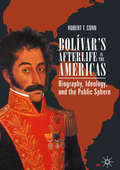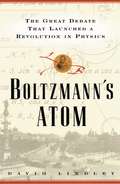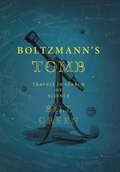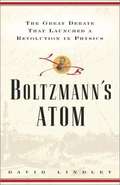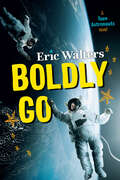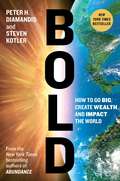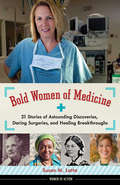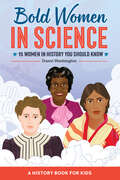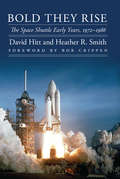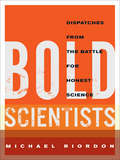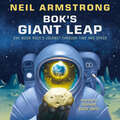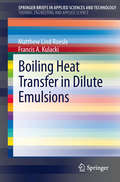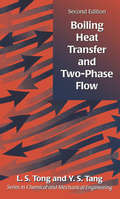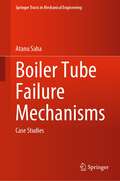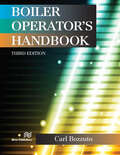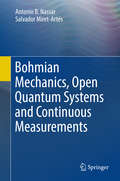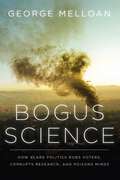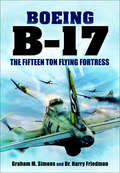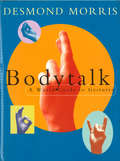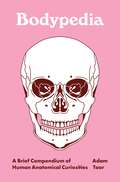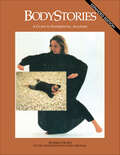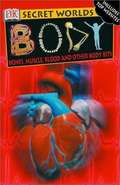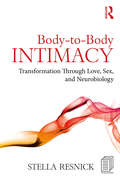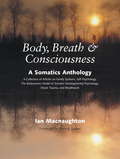- Table View
- List View
Bolívar’s Afterlife in the Americas: Biography, Ideology, and the Public Sphere
by Robert T. ConnSimón Bolívar is the preeminent symbol of Latin America and the subject of seemingly endless posthumous attention. Interpreted and reinterpreted in biographies, histories, political writings, speeches, and works of art and fiction, he has been a vehicle for public discourse for the past two centuries. Robert T. Conn follows the afterlives of Bolívar across the Americas, tracing his presence in a range of competing but interlocking national stories. How have historians, writers, statesmen, filmmakers, and institutions reworked his life and writings to make cultural and political claims? How has his legacy been interpreted in the countries whose territories he liberated, as well as in those where his importance is symbolic, such as the United States? In answering these questions, Conn illuminates the history of nation building and hemispheric globalism in the Americas.
Boltzmanns Atom: The Great Debate That Launched A Revolution In Physics
by David LindleyIn 1900 many eminent scientists did not believe atoms existed, yet within just a few years the atomic century launched into history with an astonishing string of breakthroughs in physics that began with Albert Einstein and continues to this day. Before this explosive growth into the modern age took place, an all-but-forgotten genius strove for forty years to win acceptance for the atomic theory of matter and an altogether new way of doing physics. Ludwig Boltz-mann battled with philosophers, the scientific establishment, and his own potent demons. His victory led the way to the greatest scientific achievements of the twentieth century. Now acclaimed science writer David Lindley portrays the dramatic story of Boltzmann and his embrace of the atom, while providing a window on the civilized world that gave birth to our scientific era. Boltzmann emerges as an endearingly quixotic character, passionately inspired by Beethoven, who muddled through the practical matters of life in a European gilded age. Boltzmann's story reaches from fin de siècle Vienna, across Germany and Britain, to America. As the Habsburg Empire was crumbling, Germany's intellectual might was growing; Edinburgh in Scotland was one of the most intellectually fertile places on earth; and, in America, brilliant independent minds were beginning to draw on the best ideas of the bureaucratized old world. Boltzmann's nemesis in the field of theoretical physics at home in Austria was Ernst Mach, noted today in the term Mach I, the speed of sound. Mach believed physics should address only that which could be directly observed. How could we know that frisky atoms jiggling about corresponded to heat if we couldn't see them? Why should we bother with theories that only told us what would probably happen, rather than making an absolute prediction? Mach and Boltzmann both believed in the power of science, but their approaches to physics could not have been more opposed. Boltzmann sought to explain the real world, and cast aside any philosophical criteria. Mach, along with many nineteenth-century scientists, wanted to construct an empirical edifice of absolute truths that obeyed strict philosophical rules. Boltzmann did not get on well with authority in any form, and he did his best work at arm's length from it. When at the end of his career he engaged with the philosophical authorities in the Viennese academy, the results were personally disastrous and tragic. Yet Boltzmann's enduring legacy lives on in the new physics and technology of our wired world. Lindley's elegant telling of this tale combines the detailed breadth of the best history, the beauty of theoretical physics, and the psychological insight belonging to the finest of novels.
Boltzmann's Tomb
by Bill GreenA selection of the Scientific American book clubRecommended by MSNBC, Los Angeles Times, & American Association for the Advancement of Science's SB&F magazine"This wonderful scientific memoir captures the romance and beauty of research in precise poetic prose that is as gorgeous and evocative as anything written by Rilke, painted by Seurat, or played by Casals." -Mary Doria Russell, author of Doc and The Sparrow"A radiant love letter to science from a scientist with a poet's soul . . . Green is an exquisite writer, and his fierce focus and mastery of style are reminiscent of the biologist and essayist Lewis Thomas." -Kirkus ReviewsIn Boltzmann's Tomb, Bill Green interweaves the story of his own lifelong evolution as a scientist, and his work in the Antarctic, with a travelogue that is a personal and universal history of science. Like Richard Holmes' The Age of Wonder-this book serves as a marvelous introduction to the great figures of science. Along with lyrical meditations on the tragic life of Galileo, the wildly eccentric Tycho Brahe, and the visionary Sir Isaac Newton, Green's ruminations return throughout to the lesser-known figure of Ludwig Boltzmann. Using Boltzmann's theories of randomness and entropy as a larger metaphor for the unpredictable paths that our lives take, Green shows us that science, like art, is a lived adventure. Bill Green is a geochemist and professor emeritus at Miami University in Oxford, Ohio. He is also the author of Water, Ice & Stone: Science and Memory on the Antarctic Lakes which received the American Museum of Natural History's John Burroughs Award for Nature Writing, was a finalist for the PEN/Martha Albrand Award, and was excerpted in The Ends of the Earth: An Anthology of the Finest Writing on the Arctic and the Antarctic, edited by Elizabeth Kolbert.
Boltzman's Atom
by David LindleyDescribes the history of Boltzman and his work in discovering atoms. Also goes into the philosophical debates involved.
Bolivia: The Hydrocarbons Boom and the Risk of Dutch Disease
by Eugenio Cerutti Mario MansillaA report from the International Monetary Fund.
Boldly Go: Teen Astronauts #2 (Teen Astronauts #2)
by Eric WaltersTeen astronaut Houston Williams is finally headed into outer space. Houston Williams was thrilled to win a scholarship to attend a space program at NASA. What he didn’t realize was that organizers were recruiting people for a cutting-edge research project aimed at studying how space travel affects people of different ages. Now, after months of intense training, Houston is blasting off into space! He and his new friend and former rival, Ashley, are on their way to the International Space Station (ISS) where, along with veteran astronaut Colonel Sanderson, they will be subjected to a variety of experiments. Meanwhile, back on Earth, the politics of space travel are getting complicated. Many feel the money being spent on Mars exploration should be redirected to address issues such as access to clean water and global warming. A planned mission to Mars may be accelerated before funding is canceled, and there is talk of repurposing the ISS crew. Houston doesn't dare say out loud what he's thinking: Is there a chance he could actually be going to Mars? This is the second book in the Teen Astronauts series, following Houston, Is There A Problem?
Bold: How to Go Big, Create Wealth and Impact the World (Exponential Technology Series)
by Steven Kotler Peter H. Diamandis“A visionary roadmap for people who believe they can change the world—and invaluable advice about bringing together the partners and technologies to help them do it.” —President Bill ClintonA radical, how-to guide for using exponential technologies, moonshot thinking, and crowd-powered tools, Bold unfolds in three parts. Part One focuses on the exponential technologies that are disrupting today’s Fortune 500 companies and enabling upstart entrepreneurs to go from “I’ve got an idea” to “I run a billion-dollar company” far faster than ever before. The authors provide exceptional insight into the power of 3D printing, artificial intelligence, robotics, networks and sensors, and synthetic biology. Part Two draws on insights from billionaires such as Larry Page, Elon Musk, Richard Branson, and Jeff Bezos and reveals their entrepreneurial secrets. Finally, Bold closes with a look at the best practices that allow anyone to leverage today’s hyper-connected crowd like never before. Here, the authors teach how to design and use incentive competitions, launch million-dollar crowdfunding campaigns to tap into tens of billions of dollars of capital, and finally how to build communities—armies of exponentially enabled individuals willing and able to help today’s entrepreneurs make their boldest dreams come true.
Bold Women of Medicine: 21 Stories of Astounding Discoveries, Daring Surgeries, and Healing Breakthroughs
by Susan M. LattaMeet 21 determined women who have dedicated their lives to healing others. In the 19th century, Florence Nightingale and Clara Barton—the "Lady with the Lamp" and the "Angel of the Battlefield"—earned their nicknames by daring to enter battlefields to aid wounded soldiers, forever changing the standards of medicine. Modern-day medical heroines such as Bonnie Simpson Mason, who harnessed the challenges of her chronic illness and founded an organization to introduce women and minorities to orthopedic surgery, and Kathy Magliato, who jumped the hurdles to become a talented surgeon in the male-dominated arena of heart transplants, will inspire any young reader interested in the art, science, and lifechanging applications of medicine. Lovers of adventure will follow Mary Carson Breckinridge, the "nurse on horseback" who delivered babies in the Appalachian Mountains and believed that everyone, including our poorest and most vulnerable citizens, deserve good health care, and Jerri Nielsen, the doctor stationed in Antarctica who, cut off from help, had to bravely treat her own breast cancer. These and 15 other daring women inspire with their courage, persistence, and belief in the power of both science and compassion.Packed with photos and informative sidebars and including source notes and a bibliography, Bold Women of Medicine is an invaluable addition to any student's or aspiring doctor or nurse's bookshelf.
Bold Women in Science: 15 Women in History You Should Know (Biographies for Kids)
by Danni WashingtonInspiring stories of women who changed the course of science—for kids ages 8 to 12 Women have always been at the forefront of scientific discovery. This collection of biographies for kids explores 15 of these women and their extraordinary accomplishments—even in the face of huge challenges. See how they bravely followed their dreams and revolutionized what we know about technology, our bodies, and even the universe!Explore talented women in history who helped us:Change medicine—Learn the stories of chemists like Alice Ball and Marie Daly, and how they helped cure disease and figure out the workings of the human heart.Understand the Earth—Discover botanists like Janaki Ammal and marine biologists like Sylvia Earle who created new species of plants and explored beneath the ocean.Advance technology—Find out how Ada Lovelace and Gladys West both made major advances in data science, even though they lived more than 100 years apart.Go further than other history books and read about those who are often overlooked with Bold Women in Science.
Bold They Rise: The Space Shuttle Early Years, 1972-1986 (Outward Odyssey: A People's History of Spaceflight)
by David Hitt Heather R. Smith Robert L. CrippenAfter the Apollo program put twelve men on the moon and safely brought them home, anything seemed possible. In this spirit, the team at NASA set about developing the Space Shuttle, arguably the most complex piece of machinery ever created. The world’s first reusable spacecraft, it launched like a rocket, landed like a glider, and carried out complicated missions in between. Bold They Rise tells the story of the Space Shuttle through the personal experiences of the astronauts, engineers, and scientists who made it happen—in space and on the ground, from the days of research and design through the heroic accomplishments of the program to the tragic last minutes of the Challenger disaster. In the participants’ own voices, we learn what so few are privy to: what it was like to create a new form of spacecraft, to risk one’s life testing that craft, to float freely in the vacuum of space as a one-man satellite, to witness a friend’s death. A “guided tour” of the shuttle—in historical, scientific, and personal terms—this book provides a fascinating, richly informed, and deeply personal view of a feat without parallel in the human story.Browse more spaceflight books at upinspace.org.
Bold Scientists: Dispatches from the Battle for Honest Science
by Michael RiordonAs governments and corporations scramble to pull the plug on research that proves that they are poisoning our planet and rush to muzzle the scientists who dare to share their disturbing data, it seems the powerful have declared a war on science. Michael Riordon asks deep questions of bold scientists who defy the status quo including: an Indigenous biologist who integrates traditional knowledge and a trickster’s wit; an engineering professor who exposes the myths and dangers of fracking; a forensic geneticist who traces children stolen by the military in El Salvador; a sociologist who investigates the lure and threat of mass surveillance; a radical psychologist who confronts psychiatry’s dangerous power; and a young marine biologist who risks her career to defend science and democracy. Who controls science and at what cost to the earth and its inhabitants? Can we change? This is unspun science for dangerous times.
Bok's Giant Leap: One Moon Rock's Journey Through Time and Space
by Neil ArmstrongFirst man on the moon Neil Armstrong's only children's book is a unique exploration of how the Earth and the Moon came to be.The entire epic history of the Earth and the Moon is recounted through the observations of one special moon rock named Bok. Geologists say that rocks remember, and Bok certainly does. It recounts how its life began on Earth, until a collision with an asteroid catapults it into orbit during the creation of the Moon. From the Moon's surface, Bok watches the developing planet change from afar--until a strange creature scoops him up and brings him back to Earth. When NASA honored Apollo 11 astronaut Neil Armstrong and gave him a piece of moon rock from that mission, Armstrong playfully named the rock Bok in his acceptance speech. Award-winning illustrator Grahame Baker-Smith has created a breathtaking, one-of-a-kind picture book based on that speech, combining fascinating science and history with the grandest human adventure of all.
Boiling Heat Transfer in Dilute Emulsions (SpringerBriefs in Applied Sciences and Technology #8)
by Francis A. Kulacki Matthew Lind RoesleBoiling Heat Transfer in Dilute Emulsions synthesizes recent advances and established understanding on the subject of boiling in dilute emulsions. Experimental results from various sources are collected and analyzed, including contemporary experiments that correlate visualization with heat transfer data. Published models of boiling heat transfer in dilute emulsions, and their implementation, are described and assessed against experimental data.
Boiling Heat Transfer And Two-Phase Flow
by L S TongCompletely updated, this graduate text describes the current state of boiling heat transfer and two-phase flow, in terms through which students can attain a consistent understanding. Prediction of real or potential boiling heat transfer behaviour, both in steady and transient states, is covered to aid engineering design of reliable and effective systems.
Boiler Tube Failure Mechanisms: Case Studies (Springer Tracts in Mechanical Engineering)
by Atanu SahaThis book presents failure mechanisms of different boiler components and preventive measures. It illustrates the basic steam flow and circuit design of steam boiler, boiler design parameters, boiler components materials and their behavior at different temperatures. The book aims to identify the cause(s) of in-service failure of secondary superheater tube, platen superheater tube and furnace water wall tube and also presents the solutions to avoid the future failures. This volume will be of interest to researchers and professionals working in the areas of energy, power generation, electric power plants, thermodynamics, industrial chemistry, etc.
Boiler Operator's Handbook
by Carl BuzzutoWith the increased interest in climate impacts, sustainability, and efficiency, more responsibility is being placed on boiler operators to help improve performance and reduce emissions. This third edition of the Boiler Operator’s Handbook is intended to help such operators in the quest for improved operability and performance of their boilers and their plants. The theme of this book is to "operate wisely". The goal is to instill not only "know how" but "know why". The main details have been provided by the original author, Mr. Ken Heselton. This updated version has been somewhat expanded to include a wider range of examples and some of the more recent environmental requirements. To illustrate these points, topics include multi boiler operations, understanding the plant load, maintenance issues, and controls. Every plant is different. However, it is hoped that with the information provided in this book, the wise operator will be able to address the various unique issues posed by the specific plant and provide timely solutions to meet the present-day requirements.
Bohmian Mechanics, Open Quantum Systems and Continuous Measurements
by Salvador Miret-Artés Antonio B. NassarThis book shows how Bohmian mechanics overcomes the need for a measurement postulate involving wave function collapse. The measuring process plays a very important role in quantum mechanics. It has been widely analyzed within the Copenhagen approach through the Born and von Neumann postulates, with later extension due to L#65533;ders. In contrast, much less effort has been invested in the measurement theory within the Bohmian mechanics framework. The continuous measurement (sharp and fuzzy, or strong and weak) problem is considered here in this framework. The authors begin by generalizing the so-called Mensky approach, which is based on restricted path integral through quantum corridors. The measuring system is then considered to be an open quantum system following a stochastic Schr#65533;dinger equation. Quantum stochastic trajectories (in the Bohmian sense) and their role in basic quantum processes are discussed in detail. The decoherence process is thereby described in terms of classical trajectories issuing from the violation of the noncrossing rule of quantum trajectories.
Bogus Science: How Scare Politics Robs Voters, Corrupts Research and Poisons Minds
by George MelloanThe good name of true science has been hijacked for several decades by politicians in support of dubious political goals.The good name of true science, which has transformed the world we live in marvelous ways over the last 200 years, has been hijacked for several decades by politicians seeking to employ science and scientists in support of dubious political goals. They have used their power over grants to universities and their power over federal regulatory agencies and United Nations initiatives to this end. Bogus Science examines a series of scares perpetrated by American politicians in collaboration with the UN over the last fifty years: DDT, acid rain, the "ozone hole" and of course "global warming." These scares have cost the world trillions of dollars and all have been debunked by serious scientists. Author George Melloan argues that protection of the environment is a goal that all rational people share, and the incredible advance of genuine science has brought about great strides in creating a cleaner, healthier, and safer human environment in the course of modern history. But that noble cause has been hijacked by zealots motivated by other impulses, which in the extreme derive from what some social philosophers describe as anti-humanism. "Environmentalist" claims, even when deceptive, are particularly seductive to young people seeking meaning in their lives. And sure enough, zealots have brought their influence to bear on millions of schoolchildren who have been told that their lives will be cut short if they disregard the warnings of modern Pied Pipers. While discussing the power politicians have over science, Melloan looks into the growing scandal in science about a lack of reproducibility of experiments or studies purporting to be "scientific." Real scientists know that if an experiment or a computer model is to be deemed valid, the same methodology employed by other scientists must achieve the same result. The absence of this, often in studies printed in professional journals, is shocking to many scientists. One example of flawed experiments is the great novel coronavirus panic of 2020. It was fanned by dubious data gleaned from a computer model devised by a team at the Imperial College London. It predicted 500,000 deaths in the U.K. and 2 million in the U.S. Looking at that frightening prospect, politicians ordered "lockdowns" that idled much of the global economy and threw millions of people out of work and into social isolation. They have done enormous economic and psychological damage over three months. But now we are finding that the coronavirus was nowhere near as dangerous as forecast by the computer model. And so far, the London team, like the global warming modelers and other scientists, have not revealed its methodology.
Boeing B-17: The Fifteen Ton Flying Fortress
by Graham M. Simons Dr. Harry Friedman&“Fascinating insight into the early development of the B-17 Flying Fortress . . . undoubtedly outshines other books on this significant WWII aircraft.&” —Air Mail The Boeing B-17 was the first American heavy bomber to see action in World War II when it was supplied to the RAF. The design originated in 1934 when the US Air Corps was looking for a heavy bomber to reinforce air forces in Hawaii, Panama and Alaska. For its time, the design included many advanced features, and Boeing continued to develop the aircraft as experience of the demands of long-distance flying at high altitude was gained. When the United States entered WWII, production of the aircraft was rapidly increased and it became the backbone of the USAAF in all theaters of war. This book describes how it was built and utilizes many hitherto unpublished photographs from the design studio and production lines. It illustrates and explains the many different roles that the aircraft took as the war progressed. Heavy bomber, reconnaissance, antisubmarine, and air-sea rescue operations; there were few roles that this solid design could not adopt.
Bodytalk: A World Guide to Gestures
by Desmond MorrisThe first book to bring together the many different everyday gestures that are used all over the world. Desmond Morris has travelled to over 60 countries while making field studies of human body language, and made notes of hand gestures and facial expressions. The result is a fascinating reference book of over 600 different gestures from Europe, the Middle East, North & South America and the Far East. The book is arranged alphabetically under the part of the body used with Meaning, Action, Background and Locality and each gesture is illustrated with a line drawing. The World Guide to Gestures complements Desmond Morris's bestsellers Manwatching and Bodywatching.
Bodypedia: A Brief Compendium of Human Anatomical Curiosities (Pedia Books)
by Dr. Adam TaorAn eclectic collection of strange and amazing stories about body parts you never knew you had, from acetabulum to zygomaticus majorBodypedia is a lively, fact-filled romp through your body, from A to Z. Featuring almost 100 stories on topics ranging from the beastly origins of goosebumps to the definitive answer to the Motown classic &“What Becomes of the Brokenhearted,&” these fascinating tales from your entrails explore the wonders of anatomy, one body part at a time.With a keen scalpel, Adam Taor peels away the layers to bring your underappreciated insides to light. What distinguishes crocodile tears from yours? What possessed Isaac Newton to stick a needle into his eye socket? How does brain glue thwart self-improvement gurus? Why did one of the world&’s most influential surgeons steal a giant? Providing insights into these and other curiosities, Taor illuminates the ingenuity, mystery, and eccentric history of your anatomy like never before. Along the way, you will meet the geniuses, mavericks, and monsters (sometimes all the above) who got their hands bloody discovering, dissecting, and naming your parts.With beautiful drawings by Nathalie Garcia, Bodypedia celebrates what makes you tick, and reveals why the best stories are hidden inside you.Features a cloth cover with an elaborate foil-stamped design
BodyStories: A Guide to Experiential Anatomy
by Andrea Olsen Caryn McHoseBodyStories is a book that engages the general reader as well as the serious student of anatomy. Thirty-one days of learning sessions heighten awareness about each bone and body system and provide self-guided studies. The book draws on Ms. Olsen's thirty years as a dancer and teacher of anatomy to show how our attitudes and approaches to our body affect us day to day. Amusing and insightful personal stories enliven the text and provide ways of working with the body for efficiency and for healing. BodyStories is used as a primary text in college dance departments, massage schools, and yoga training programs internationally.
Body: Bones, Muscle, Blood and Other Body Bits
by Richard Walker Jayne ParsonsIt's a weird world out there. . . dazzle your friends with wacky facts and more from this mega new series. Did you know. . . The smallest bone in your body, the stirrup bone, lives deep inside your ear. A sneeze can burst through your nostrils at an astonishing 160 mph. A nerve impulse takes on hundredth of a second to travel from your big toe to your spinal cord. A full-color, fun, and informative series, Secret Worlds offers a chance to get your teeth deep into a wide range of fascinating subjects from nature, history, and science. Every title has: Easy-to-read narrative text written by a specialist who combines expert knowledge with an entertaining and fresh style. Superb color photography that entices the reader into the subject world with close-up views and dramatic shots. Weird World feature boxes that reveal a wealth of wacky facts. Tried-and-tested websites to check out the latest info. A mega reference section with even more facts and figures for the enthusiast. Suitable for children aged ten and up -- as well as every other family member who is curious about the subject.
Body-to-Body Intimacy: Transformation Through Love, Sex, and Neurobiology
by Stella ResnickThis book presents an integrative, growth-oriented approach to therapy with couples that demonstrates the dynamic interplay between partners’ emotional issues and their sexual difficulties. It offers a model for relational and sexual enhancement that focuses as much on partners’ present, nonverbal body-to-body communications as on their words. Dr. Stella Resnick draws on research from interpersonal neurobiology, sexology, positive psychology, and Gestalt therapy, and shares a rich assortment of therapy vignettes to demonstrate the transformative power of pleasure and how a focus on body-to-body intimacy can heal emotional wounds from the past and encourage greater presence, empathy, authenticity, playfulness, and sexual pleasure between intimate partners. The therapeutic process is explored in four related spectrums: the Problem-Transformation Spectrum, the Attachment-Sexuality Spectrum, the Pain-Pleasure Spectrum, and the Cognitive-Somatic-Experiential-Behavioral-Spectrum. Part I lays the theoretical foundation for the work. Part II examines the early attachment bond between parent and child and its effects on adult capacity for emotional closeness and sexual pleasure. Part III offers methods for resolving painful emotional issues underlying many sexual difficulties. Finally, Part IV describes the procedure for moving from a cognitive reframing of the problem to a somatic focus on the body and tracking present-moment emotional interactions to the repair of relational injuries that nurture transformational change. Also included is a series of process-oriented exercises and a handout that therapists can use in their own practice. Body-to-Body Intimacy will enable couples and sex therapists to expand their practices and enrich their clients’ sexual and relational dynamics. This book also contains valuable information that will be appreciated by anyone interested in a greater understanding of a growth-oriented therapeutic process for couples and what can be achieved together by gaining a deeply loving and sexually fulfilling intimate love relationship.
Body, Breath, and Consciousness
by Peter A. Levine Ian MacnaughtonThe forces that develop the self--somatic, emotional, mental, interpersonal, social, and spiritual--must all be considered by therapists in treating any patient. Each article in this important anthology deals in some way with these various elements. The writing is focused on the body-mind connection, exploring the practices and theories of this popular branch of psychology. Topics include the significance of family systems; dealing with trauma and shock in therapy; and the importance of breathing, offering valuable insights for the student and practitioner alike. Contributors include Marianne Bentzen, a trainer in Somatic Developmental Psychology; Peter Bernhardt, a professor of psychology; and Peter A. Levine, author of Waking the Tiger.
